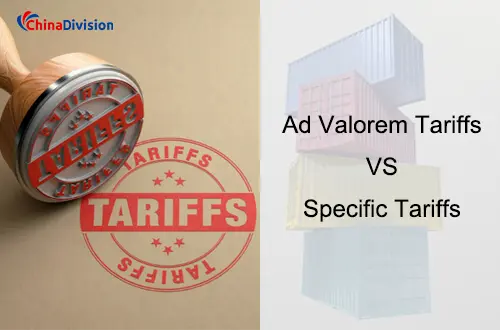The Difference Between Ad Valorem and Specific Tariffs
Tariffs not only affect product pricing but also directly impact business profits. Ad valorem tariffs are the most common type of tariff, levied as a percentage of the transaction value of imported goods.
Table of Contents
- What are tariffs and their types?
- What is an ad valorem tariff?
- What is a specific tariff?
- Key Differences Between Ad Valorem and Specific Tariffs
- Which is better for me, ad valorem or specific tax?
- Answers to 5 in-depth questions businesses are most concerned about
- How can ChinaDivision help you address tariff challenges?
As an international e-commerce seller or B2B company, a precise understanding of tariff types—particularly the difference between ad valorem and specific tariffs—is crucial for controlling costs and improving competitiveness. This article will provide an in-depth analysis of the two core tariff models and reveal how professional service providers can reduce tariff costs through compliance strategies.
What are tariffs and their types?
Tariffs are taxes levied by governments on imported goods. The main types include:
Ad valorem tariffs: Calculated as a percentage of the total value of imported goods.
Specific tariffs: Fixed charges per unit, weight, or quantity imported.
Compound tariffs: Combining ad valorem and specific tariffs. Reciprocal tariffs: Match the tariffs imposed by trading partners.
What is an ad valorem tariff?
An ad valorem tariff is a percentage of the dutiable value of a good (usually the CIF price: cost, insurance, and freight).
For example, if the CIF value of a good is $10,000 and the tariff rate is 8%, the duty payable is $800.
The amount of the tariff fluctuates with the price of the good; the higher the price, the higher the tax.
Advantages:
The tax burden is more reasonable and reflects the value of the good.
It is applicable to a wide range of goods, especially goods with volatile prices, such as artwork and new products.
It facilitates international tariff negotiations and comparisons.
Disadvantages:
Customs valuation is complex and can lead to disputes.
High-value goods may face high tariffs.
What is a specific tariff?
A specific tariff is a fixed amount levied based on the quantity, weight, or volume of the good.
For example, a 1.22 kilogram tariff is imposed on each imported kilogram of cheese, regardless of its market price.
Advantages:
Stable tax amounts make budgeting easier.
Especially advantageous for low-value, high-weight goods.
Disadvantages:
Does not reflect the actual value of goods and may be unfair to high-quality goods.
Protective effect is less pronounced during price fluctuations.
Key Differences Between Ad Valorem and Specific Tariffs

Tax Basis: Price vs. Physical Quantity
Ad valorem tariffs: Levied proportionally based on the dutiable value (CIF) of goods.
Specific tariffs: Levied based on physical units such as quantity and weight.
Tax Rate Flexibility: Dynamic Adjustment vs. Fixed
Ad valorem tariff rates fluctuate with market prices.
Specific tariff rates are fixed.
Applicable Goods
Tariff Types
Typical Goods Subject to Ad Valorem Taxes: Manufactured Goods and Luxury Goods. Tax Avoidance Traps: Under-reporting of goods values, leading to customs revaluation.
Typical Goods Subject to Specific Tariffs: Raw Materials and Commodities. Tax Avoidance Traps: Underpayment due to unit conversion errors.
Cost Impact Curve
Ad valorem tax costs are positively correlated with price and are suitable for goods with stable prices.
Specific tax costs are positively correlated with quantity and are suitable for goods with large price fluctuations.
Complexity of Customs Valuation
Ad valorem tax requires complete CIF value certification (including freight, insurance, and ancillary costs).
Specific tax only requires verification of the quantity/weight of the goods.
Which is better for me, ad valorem or specific tax?
High-value goods: They are generally more afraid of ad valorem tax. For example, a watch worth $1,000 would cost $50 if 5% ad valorem tax was applied. If a specific tax were applied, say $10 per piece, the ad valorem tax would be much higher.
Low-value goods: They are generally more afraid of specific tax. For example, a kilogram of screws worth $5 would only cost $0.25 if 5% ad valorem tax was applied. However, if the specific tax were $2 per kilogram, this fixed cost would be very high.
Most countries primarily use ad valorem tariffs, but some goods (such as agricultural products and raw materials) may be subject to specific or combined tariffs.
Answers to 5 in-depth questions businesses are most concerned about
How are compound tariffs calculated?
A compound tariff = ad valorem + specific. For example, the import tax on an electrical appliance = value of the goods x 5% + $10 per unit. This type of tariff will apply to semiconductor equipment shipped from the US to China in 2025. Companies need to monitor both price and quantity fluctuations.
How can I determine which tariff type applies to a product?
Answer: Check the tariff type in column 1 of the HTS code.
Confirm the rules of origin (e.g., the USMCA requires a regional value content of ≥ 55%).
Assess the risk of price volatility (specific tariffs are recommended for fluctuations > 15%).
What type of anti-dumping duty is an ad valorem?
Anti-dumping duties (ADDs) are typically imposed in the form of ad valorem. For example, in 2025, the US imposed a 25% anti-dumping duty + a 10% Section 301 duty on Chinese steel, resulting in a compound ad valorem structure.
Can the tax burden be reduced by lowering the declared value of an ad valorem tariff?
Not recommended. Customs reserves the right to re-evaluate, and under-declaration may result in fines or detention. ChinaDivision provides compliant declaration services to ensure smooth customs clearance.
How can you reduce the cost pressures caused by ad valorem tariffs?
You can reduce CIF values by optimizing your supply chain, selecting the right fulfillment center, and consolidating orders. ChinaDivision has multiple fulfillment centers across China, helping clients ship locally, reducing freight and insurance costs, and thus reducing tariff expenses.
How can ChinaDivision help you address tariff challenges?
As a professional third-party fulfillment service provider, ChinaDivision not only provides warehousing, order processing, and global delivery services, but also supports clients in tariff management. Understanding the difference between ad valorem and specific tariffs is essential for every cross-border seller navigating the global market. With a third-party fulfillment service provider like ChinaDivision, you can not only reduce tariff costs but also improve fulfillment efficiency and customer satisfaction.
ChinaDivision's third-party fulfillment services are designed to address tariff challenges, helping you:
Reduce your tariff costs through accurate classification, optimized transportation, and strategic warehousing.
Streamline your international shipping process, ensure compliance, and minimize delays.
Improve customer satisfaction by eliminating unexpected fees and providing faster delivery.
You can rest assured that your logistics are handled by experts who understand the complexities of global trade.
Don't let ad valorem tariffs hinder your global growth. Contact Chinadivision today to learn how our comprehensive logistics solutions can help your B2B business or e-commerce platform thrive in international markets. We'll handle the logistics for you, allowing you to focus on what you do best: growing your business.





